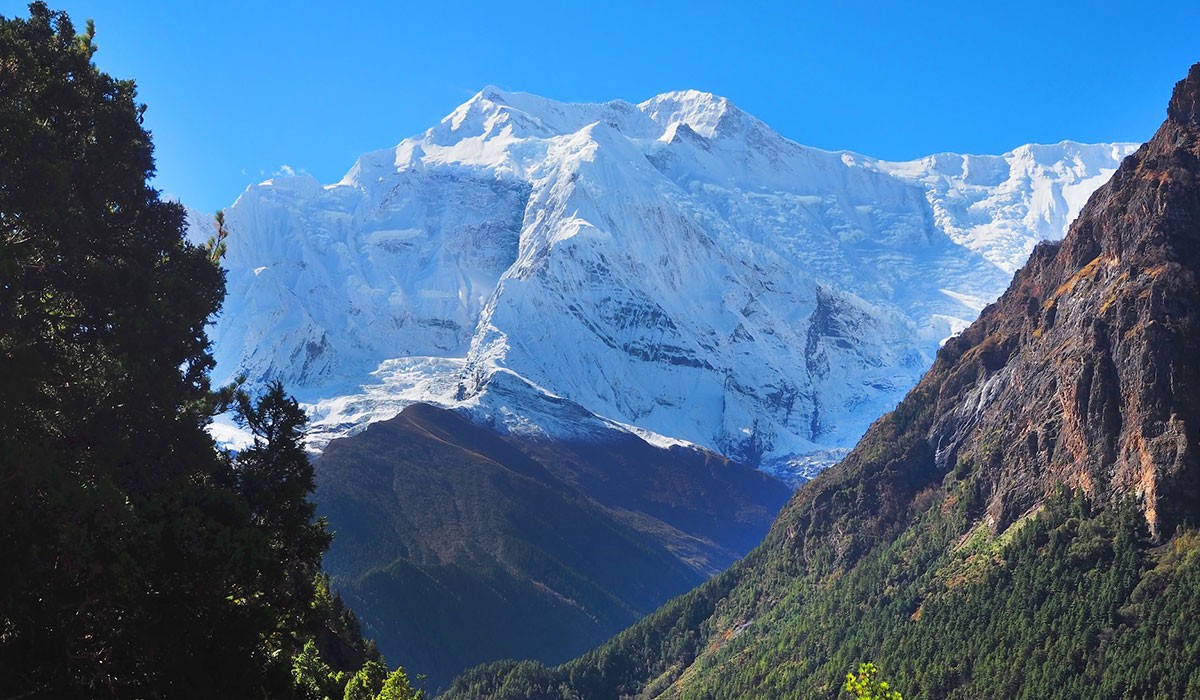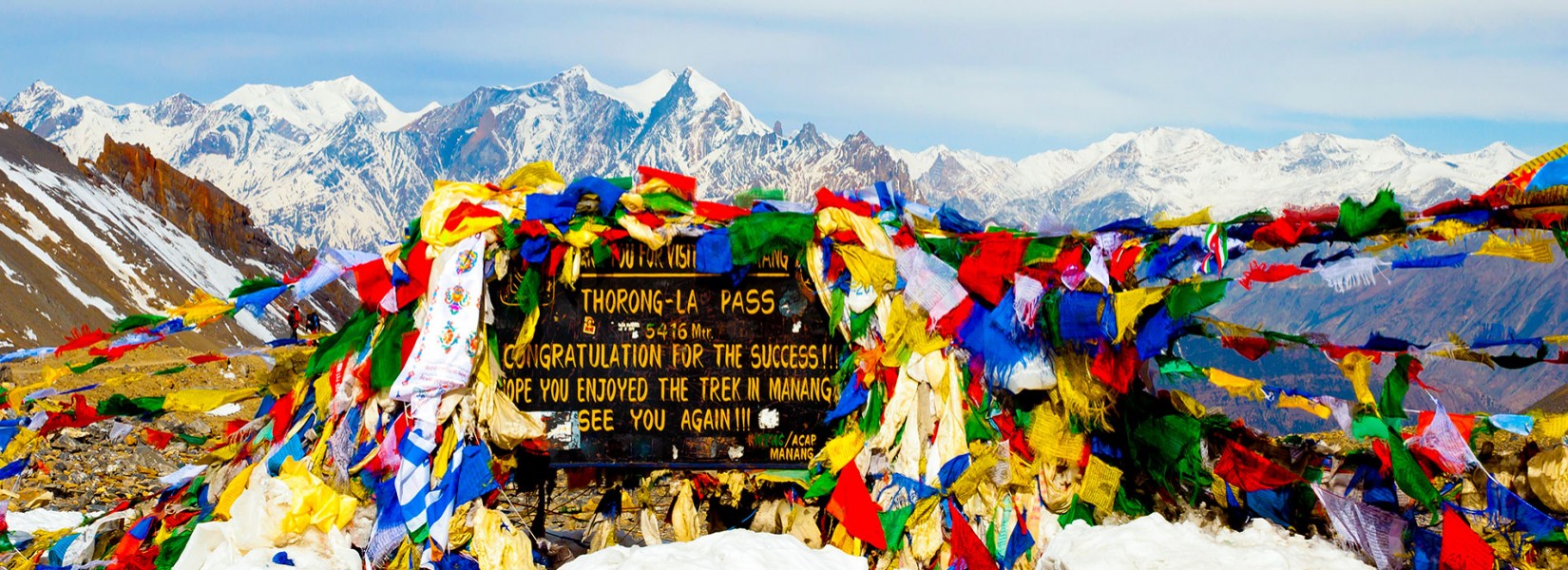Best Season for Annapurna Circuit Trek 12 Days
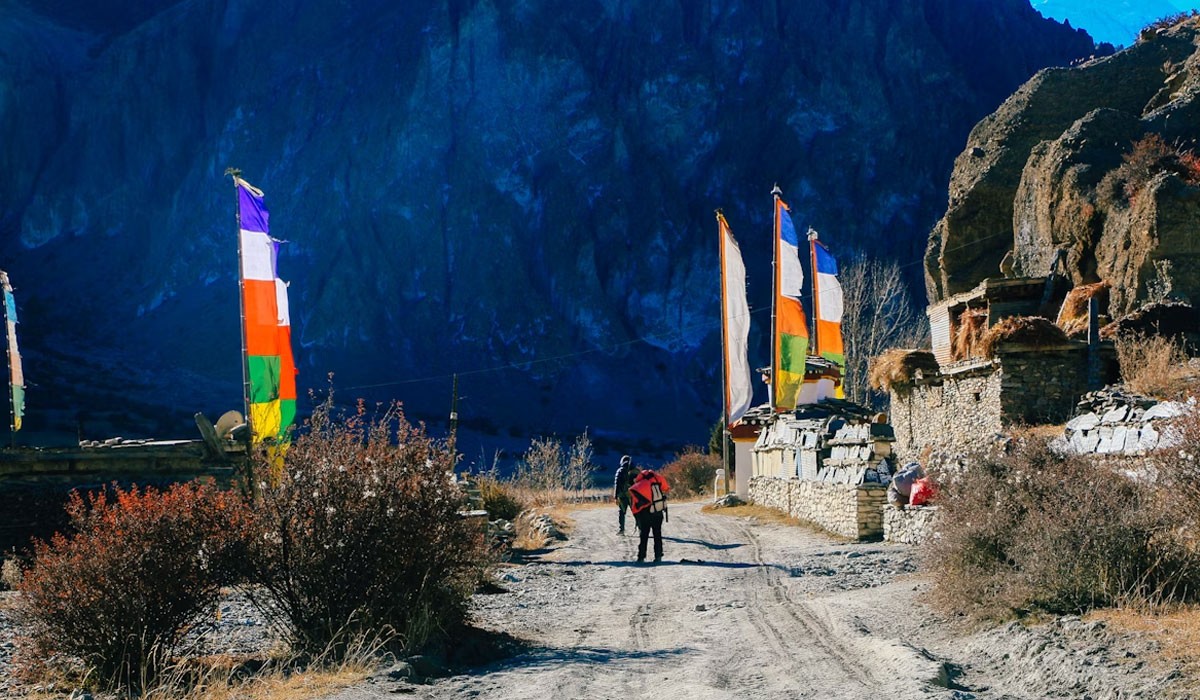
The most ideal time for Himalayan trekking and mountain expeditions in Nepal is considered to be during spring (March to May) and autumn (September to November). These peak seasons offer stable weather conditions, dry trekking trails, lush landscapes, clear mountain views, and the opportunity to explore the cultural prospects of the natives in the festive vibe. So, if you are planning to do this trek, these are the ultimate seasons for the best value Annapurna Circuit Trek experience.
Although both spring and autumn are top contenders for this wonderful Himalayan adventure, each of these seasons adds their magic to your exploration. Let’s break down what both these peak seasons bring to the table.
Annapurna Circuit Trek in Autumn
Autumn season is dubbed as the number one season for the Himalayan trekking adventures, especially due to its mild temperature, clear days, and picturesque unobstructed views of the Himalayan massifs. The unique, colorful shades of the fall season, high-flowing rivers, and lush landscapes nourished by the monsoon rain add further excitement to your Himalayan exploration.
The temperature of the Annapurna region is around 15° C to 17° C during the daytime and can drop up to 5° C at night and early mornings. You can expect the night temperature to be minus degrees at high altitudes above 4,000 meters.
Highlights of the Autumn Season
- Mild trekking temperatures
- Clear skies and panoramic views of the Himalayas
- Colorful landscapes with stunning shades of the fall season
- High visibility for stunning photography
- Less crowded trekking trail than in the spring season
- Opportunity to explore the cultural prospects of the country
- Culinary delights of the harvest season
- Fresh rain washed lush landscapes
Annapurna Circuit Trek in Spring
Spring season in the Himalayas is typically known as the blooming season; you can expect nature to be in its prime during this season. The stunning visuals of diverse colors, warm temperatures, clear mountain views, and stable weather conditions of the spring season make the Annapurna Circuit Trekking route a natural paradise.
You will have a high probability of witnessing the endangered Himalayan wildlife during this season. Also, the migratory birds from all around the world make up the perfect time for bird watching. The normal temperature of the Annapurna region averages around 14° C at higher altitudes, but you can expect it to hover around 18° C to 20° C at the lower regions.
Highlights of the Spring Season
- Blooming trails decorated with dotted rhododendrons and other wildflowers
- Pleasant temperature even at higher altitudes
- Opportunity to explore endangered Himalayan flora and fauna of the Annapurna Conservation Area
- Stable weather and clear views of mountains
- Longer daylight hour
- Favorable climatic conditions for outdoor activities
- Incredible waterfall and sparkling stream nourished by the melting snow
- Comfortable and well-equipped teahouses and lodging facilities along the trail
How Difficult is 12 Days Annapurna Circuit Trek?
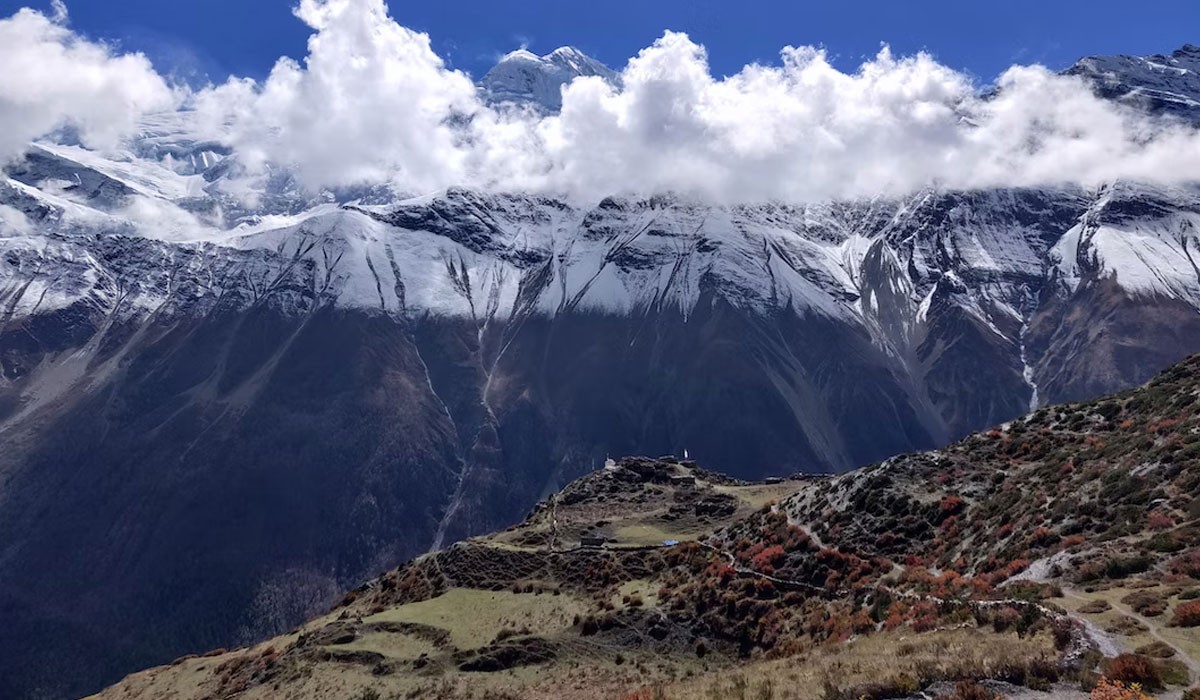
Annapurna Circuit Trek is one of the most popular Himalayan trekking adventures in the world. It won’t be a stretch to say that this adventure is something that you definitely have to try at least once in your lifetime if you are a trekking enthusiast. If you are looking forward to this Himalayan adventure and wondering about its difficulty level, fret not; this iconic Himalayan exploration is just at a ‘moderate’ difficulty level.
You don’t need any prior Himalayan trekking experience or technical skills to do this trek. But, as this is a Himalayan adventure that takes place in remote and steep sections, you should be well prepared to overcome the hurdles that you have to face during your expedition for a comfortable and enjoyable experience. Let’s discuss some of the difficult factors of this trek that you have to face during your exploration.
Altitude Sickness
Altitude sickness is a major concern during any kind of high-altitude adventure as it is difficult for the human body to properly adapt to the environment over an altitude of 3,500 meters. Thus, this classical Himalayan adventure that takes you to altitudes over 4,000 and 5,000 meters can be challenging if you haven’t made enough preparation.
Starting your adventure at Ngadi (930 meters), you move along the high elevation points on this adventure, like Yak Kharka (4,120 meters), Thorong Phedi (4,560 meters), and the highest elevation point of this adventure Thorong La Pass (5,416 meters).
Trekking Distance
You will cover an approximate trekking distance of 160 km to 230 km while trekking the Annapurna circuit. So, you will walk about 6-7 hours during each day of the trekking adventure; it can be a demanding feat to pull if you haven’t made enough preparation for the long hours of walking. On top of that, trekking at higher altitudes can be even more vexing as you can get easily tired with even simple tasks.
Remoteness
Annapurna region is a remoter Himalayan destination, so the services and amenities here are not on par with a luxurious destination. Besides the remote-rugged trails that you have to overcome during your trekking days, the facilities at the eatery and lodging establishments are on a moderate scale as they are run by natives. Similarly, the transport facilities in the region are limited, and there are very few health institutions along the trekking trail. So, you have to prepare yourself mentally and physically to overcome these hurdles for an enjoyable experience.
Weather Factors
If you are planning to trek the Annapurna circuit on off-seasons like winter (December to February) and monsoon (June to August), you will have to overcome the challenging weather factors as well. Annapurna region is extremely cold during the winter season, and snow covers almost all of the trekking trails in the higher region. So, you will have to carry extra gear and clothes to keep yourself warm during this season.
As for the monsoon, its continuous downpour makes the trekking trail slippery and dangerous. You might often have to postpone your road travel, and the potential danger of natural disasters like landslides and flooding adds risk to your Himalayan adventure.
Is This Trek Right For Me?
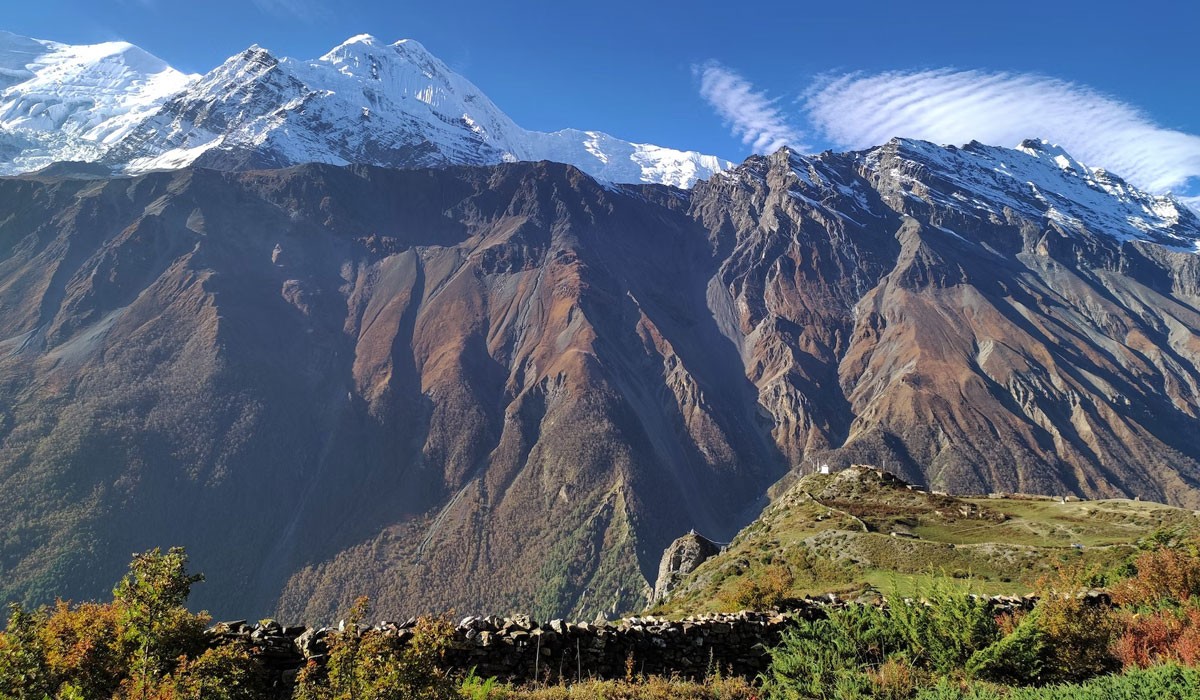
This exhilarating and classical trekking expedition in the Himalayas is an ideal package for even beginners. Even if you are completely new to the Himalayan trekking adventures, with enough preparation and determination you will be able to easily complete this trek. A basic level of fitness and good health condition will be sufficient for you to make this trek an enjoyable experience if you are willing to put in some effort during the preparation part.
The success rate of the Annapurna Circuit Trek is about 98% to 100%; even if this is a high-altitude adventure, you will enjoy slow-paced walking during each day. You will also get enough acclimatization days to properly adapt to the rising altitude and minimize the risk of altitude sickness. As there have been records of even children and elderly trekkers completing this classical Himalayan adventure, if you are determined, you will be able to easily complete it.
Training and Preparation
Training and preparation is a crucial step to make your adventure enjoyable and memorable. The minimum recommended preparation period for this trekking adventure is 4-6 weeks; you can do a thorough physical assessment to decide the duration and the effective training for this trek. If you work out routinely, you may not have to put in many hours during your preparation; however, in case if you are not that physically active, you may need to put in extra effort.
For the most effective preparation, you can do some practice on steep landscapes closer to you, carrying a backpack with significant weight. This will work as the perfect stimulation of the adventure that you can expect during your actual trek. Also, don’t forget to break in your trekking boots during the practice hike; it will help you to understand the comfort level of your boots. Here are some exercises that are recommended for your training program:
Strength and Endurance Training: Push-ups, pull-ups, plank, bicep curls, squats, weightlifts, leg extensions, bench presses, lateral raises, deadlifts, lunges, etc.
Cardiovascular Exercises: Jogging, cycling, jumping jack, burpees, swimming, jumping rope, rowing, power walking, mountain climbing etc.
Food and Accommodation
Annapurna region is the second most popular trekking destination in the Himalayas. Compared to other remote destinations, the trekking routes in this region are well-developed and accessible by road to certain points. So, you can expect moderate to top-tier food and accommodation facilities during your adventure.
As this is a teahouse trekking adventure, you will rest at comfortable lodging facilities run by the natives. You will stay in a well-furnished room, generally with two or three adjacent beds; you will receive a comfortable mattress, pillow, and blanket during your stay. As for the bathroom facilities, you will use a shared bathroom like your room in a standard trekking package; you can switch to luxurious options for a more personalized experience.
On the topic of food during your expedition, you can expect a wide range of delicacies in this mainstream trekking route of the Himalayas. Besides the delicious local delicacies, you will also be able to enjoy the Tibetan and Indian culture-influenced dishes as well as some of the top continental cuisines. You can expect the following menus at the teahouses during your trekking adventure:
For Breakfast: Tea, coffee, juice, toast, eggs, cornflakes, oats, paratha, chapati, muesli, porridge, pancakes, etc.
For Lunch and Dinner: Dal Bhat Tarkari, pizza, pasta, salad, soup, dumplings, spaghetti, Macaroni, fries, momo, Chowmein, Thukpa, etc.
What About Water?
During your trekking expedition, you are recommended to drink at least 3-4 liters of water each day of your trek to avoid altitude sickness. As you have to fulfill the required hydration quota, buying bottled mineral water at the teahouses can be slightly costly. We also don’t recommend buying plastic water bottles to preserve the environment
So, our experienced guide will fill up the bottle from a clean resource and you can use purification tablets or solutions to make the drinking water safe.
Read this next:
For Map
To understand your overall Himalayan journey better, here is the detailed map that your Annapurna Circuit Trek 12 Days itinerary plans will follow. The highlights along the trail are clearly marked on the map, and your guide will provide you with all the details about other highlights along the trail that are not mentioned on the map. We will provide you with a guidebook that has more detailed version of the Annapurna Circuit Trek map.
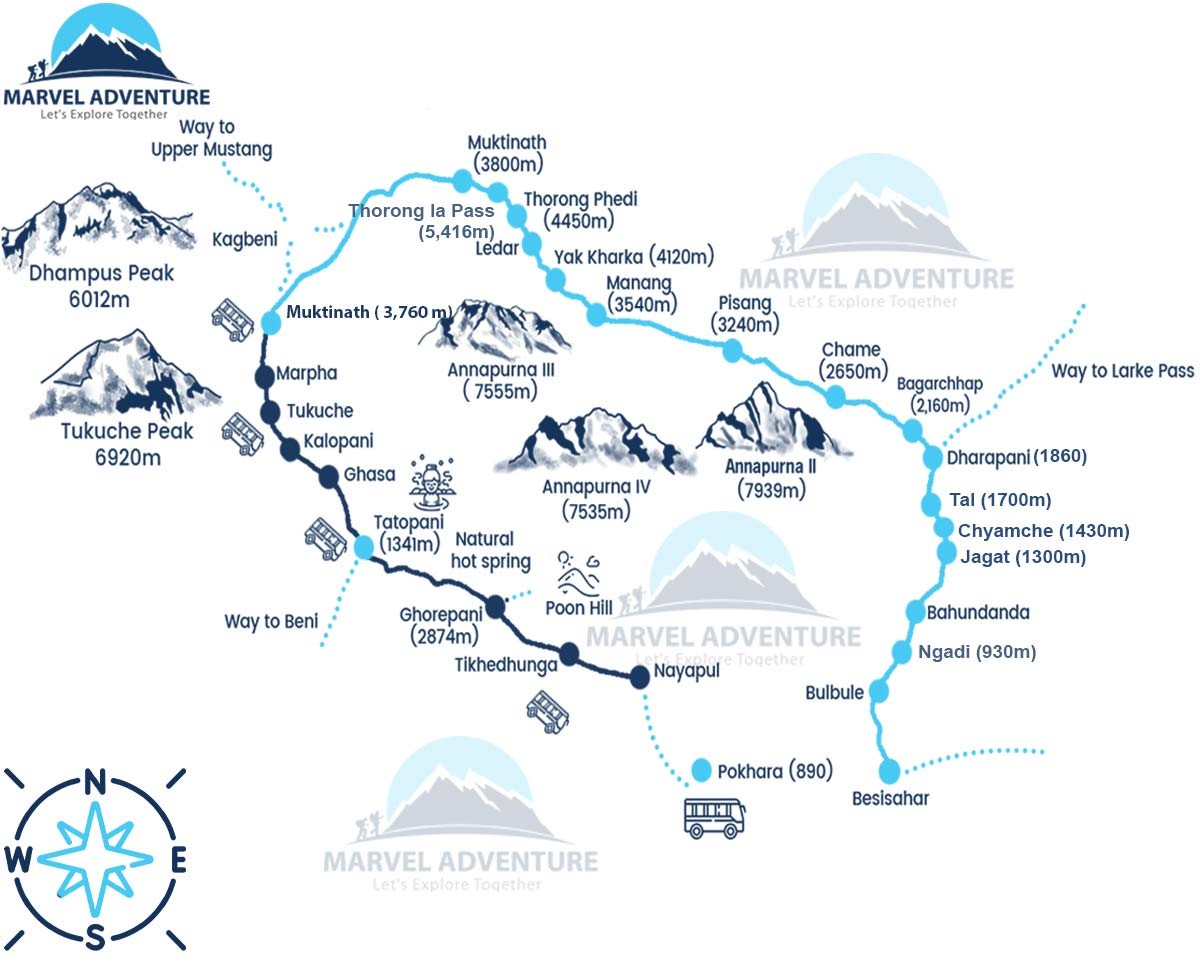
Private Joining and Group Joining
If this is your first time doing the trek in Nepal, there are actually two types of trek groups joining with the agencies: private joining and group joining. The same goes for this 12 Days Annapurna Circuit Trek; if you are doing this trek alone, group joining is the most viable option. In the group joining option, after setting a start date, trekking enthusiasts from all across the world are allowed to join until the group size reaches the maximum limit.
As the start dates are already set, there isn’t flexibility in the group joining, and you will be trekking with other trekkers that you are not familiar. In case if you are traveling with your friends and family and want to avoid strangers joining your trekking group, private joining is the most suitable option for the Annapurna Circuit Trek 12 Days. As only your group will be joining, you can decide on the group size and the start date for the trip as per your flexibility.
Internet and Charging
The Annapurna Circuit Trek 12 Days takes place in a major and mainstream trek destination in Nepal. This region also has more access to roadways, so the infrastructural and technological development here is more advanced than other regions. So, your internet and charging facilities are available across the trekking route. Even if you are not happy with the bandwidth at the teahouses, you can also easily buy data packages with major telecommunication companies like NTC and Ncell to stay connected with the world.
Similarly, you can charge your devices at the teahouses along the trail, even at the stop point where you are taking short breaks. The cost for charging your device and using a connection is pretty much the same; teahouses charge around US$ 1 to US$ 2 per hour. However, these services are more costly at the higher altitudes where settlements are solar power reliant.
Luggage Store
While doing the 12 Days Annapurna Circuit Trek, you might be wondering about how to store the extra luggage that you will not need for the trek. There are two ways to securely store your luggage. You can either leave it at the hotel you are staying in, or they will charge a daily for storing your luggage. Or, you can leave your baggage under our care while you are exploring the beauty of the Annapurna region. We don’t charge a single penny to store your luggage at our office.
Booking Procedure
The booking procedure for Annapurna Circuit Trek 12 Days is swift and easy with Marvel Adventure. You can easily book the package from the products page and fill in the necessary details to validate your booking. For an easy interface, we have also included the customize trip button along with the booking option as well so you can enjoy the adventure of your preference. After your booking is confirmed, our sales department will contact you. You can also get directly in touch with use from our Contact Page.
**Note: We also do offer last-minute booking services with us; trekkers will have to pay the full amount upfront for such short notice booking**
Nepal Visa Info
Depending on the length of your stay in the country, you can decide on which Nepali Travel Visa you want to buy for your trek. You can either acquire the travel visa before your arrival at the nearest Nepali embassy or you can get it on your arrival at the Tribhuvan International Airport (TIA). You can check out this On Arrival Visa National List to find out if an on-arrival visa is provided to the residents of your country or not.
Here are three arrival vias given at the entry point in Nepal:
- 15 days travel visa= US$ 30
- 30 days travel visa= US$ 50
- 90 days travel visa= US$ 125
As for the visa extension, you will need to get at least 15 days of visa extension, which will cost US$ 45. In case of delays for visa extension below 150 days, you will had to pay US$ 5 as late fine for each day.
Payment Terms
After confirming your booking for the package, you will need to pay 20% of the total cost upfront and submit a copy of your passport. This assures us about you joining the trip, and we will proceed toward the booking for services for Annapurna Circuit Trek 12 Days itinerary plans. As for the remaining amount, the payment can be made through bank draft, bank account wire, or cash. If you use a credit card, about 4% of the bank processing fee will be charged.
As for our cancellation policy, if you have booked the package with just 20% advance, that amount is not refundable as we proceed toward booking fo services for your trek. If you have paid the full amount in advance, the refundable policy will depend on the notice period. You can check out the cancellation policy in detail here.
**Note: If you, for some reason, cannot join the trek at the set date during your booking, you can also postpone your adventure for any dates later which is feasible for your**
Personal Expenses
Your 12 Days Annapurna Circuit Trek cost will cover all the general expenses for the trek. For instance, food and accommodation, land transportation, permits, guides and porters, first aid, etc, are covered by our standard package. However, as for the personal nature expenses, you will have to pay for them out of your own pocket. Some examples of personal expenses that will incur during your trek in the Annapurna region are refreshment drinks, snacks, desserts, laundry, hot shower, internet, charging, satellite calls, etc.
Hot Shower and Laundry
You will be able to enjoy hot showers in this mainstream central Himalayan route. The teahouses at the trailside in the lower region have a Western-style interior design with flush and hot shower systems. As for the trekking part during remote high-altitude regions, teahouses provide buckets with hot water for bathe. Laundry is also the basic service provided by the teahouses; most of them use washing machines to wash and dry clothes and linens.
**Note: The 12 Days Annapurna Circuit Trek cost for laundry and shower starts at US$ 2 at lower region and can reach upto US$ 5 at higher altitudes.
Purchasing or Renting Gear in Kathmandu
If you don’t have your own set of gears for the 12 Days Annapurna Circuit Trek, you can easily buy or rent it at Kathmandu. Marketplaces like Thamel and Assan, which are tourist have several gear shops where you can find the equipment you need. If you are planning to keep chasing your passion for trek, it will be more efficient to buy gear instead of paying daily charges. However, make sure to check the build and quality of the gear, as there are many fake copies in the market.
The cost of renting trekking gear in Kathmandu is around US$ 1 to US$ 5 per day, depending on the type. As for the buying cost of the gear, the cost can start as low as US$ 5 and cross even US$ 1,200.
**Note: Marvel Adventure also provides basic personal trekking gear like a trekking pole, sleeping bag, down jacket, and duffle bag absolutely free of cost**
Currency Exchange
As the standard Annapurna Circuit Trek 12 Days packages do not cover personal expenses, you will need to consider proper budgeting for day-to-day expenses. Besides snacks and refreshments break along the trail, you will also need extra cash for shower, laundry, charging, tipping, shopping, etc. You should exchange the cash required for the trek at Kathmandu, as the exchange rate on the mountain may not be fair. You can check the current official exchange rate for currency from the Nepal Rastra Bank foreign exchange rates page.
**Note: You don’t need to necessarily convert all the cash into Nepali rupees; you can also keep changes for other popular acceptable currencies like dollar and pound**
Guide and Porter
Annapurna Circuit Trek 12 days is a high-altitude journey that takes you across the remote part of the central Himalayas, and even one of the challenging Himalayan passes. Doing such high-altitude treks without any familiarity with the region can be challenging and, at some point, even life-threatening. That’s why now it is mandatory to take a licensed guide for high-altitude exploration. The trekking guides who are experienced in the route make the journey informative, comfortable, and safer as they understand the region like the back of their hand.
On top of that, the guides are also responsible for taking care of your health. They make sure that your health condition is at an optimum level before proceeding further and take appropriate action in case of emergencies. Besides those, guides also take care of the logistics details so you can immerse in a hassle free journey. As for the porters, they are mostly the inhabitants of the region and take care of your luggage.
**Note: The cost of hiring a guide for the 12 Days Annapurna Circuit Trek is about US$ 30 to US$ 35 per day, and as for the porter, it is about US$ 20 to US$ 25 per day (without including tips)**
Hotel Pick-Up and Drop-Off
During your 12 Days Annapurna Circuit Trek, Marvel Adventure will take care of all your transport needs. You don’t need to take a domestic flight on this trek (the flight from Kathmandu to Pokhara route is an option), and we will take care of all transport needs in between while moving along with the Annapurna Circuit Trek 12 Days itinerary. Even after completion or before the start of the trek, if you need any kind of land transportation for your travel activities, we will make the arrangements for those as well.
Tipping
Tipping is an obligation in the service industry; however, it is not mandatory while trekking in Nepal. Although there aren’t any official laws for tipping culture in Nepal for the trekking world, it is certainly expected. Trekking is a seasonal business that is at its peak during the high season like spring and autumn; for the rest of the year, only a few numbers of trekkers visit the trekking trail in the country. For natives who entirely depend on the trekking business, tipping is a welcome gesture that helps their financial situation. So, take it as a way of showing gratitude for the incredible Himalayan trekking experience that was possible due to this hardworking gentlemens.
**Note: Instead of handing out cash, which can be seen as disrespect, put the tip in an envelope and give it to the guide and porters. The general tipping margin for porter is US$ 10 to US$ 15 per day and for guide its US$ 20 to US$ 25 per day**
FAQs About Annapurna Circuit Trek
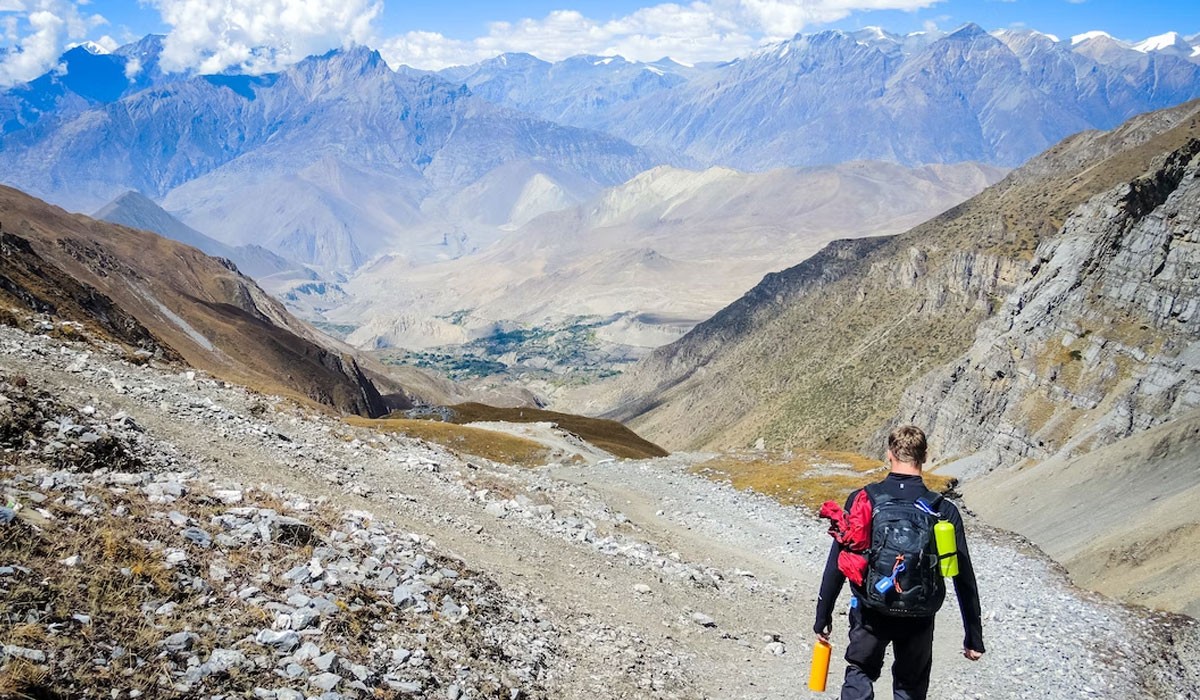
How long is the Annapurna Circuit Trek?
The Annapurna Circuit Trek lasts somewhere between 12 to 22 days, depending on the itinerary plans and side detours.
Can a beginner do Annapurna Circuit Trek?
Yes, the Annapurna Circuit is suitable for beginners; you don’t need any previous trekking experience or technical skills to do this trek.
Is Annapurna or Everest harder?
In comparison to the altitude gain and remoteness of the trekking trail, the Everest Base Camp trek is slightly more challenging and demanding than the Annapurna circuit.
What level of fitness do you need for Annapurna Circuit?
If you have good health conditions and a basic level of fitness, you will be able to complete the Annapurna circuit easily.
What is the hardest part of the Annapurna Circuit?
Thorong La Pass, one of the high Himalayan passes at an elevation of 5,416 meters (17,769 feet), is considered the hardest part of the Annapurna circuit.
How many km is Annapurna Circuit?
Annapurna Circut Trek covers an approximate trekking distance of 160-230 km, depending on the exploration route.
How do I prepare for Annapurna Circuit?
You are recommended to start your training at least 4-6 weeks before your expedition and emphasize strength, endurance, and cardiovascular exercises.
Can you see Mt. Everest from Annapurna Circuit?
No, it is not possible to see Mt. Everest during your Annapurna circuit as it takes place in a different part of the Himalayas, north-central.
Can children do Annapurna Circuit?
Although children in the past, even children and elderly trekkers above the age of 70, have completed this trek, children under the age of 13 are not recommended to do this trek.
How much does it cost to trek the Annapurna Circuit?
The Annapurna circuit trek cost can range somewhere between US$ 900 to US$ 4,000, depending on the itinerary plans, exploration route, services, and amenities.
